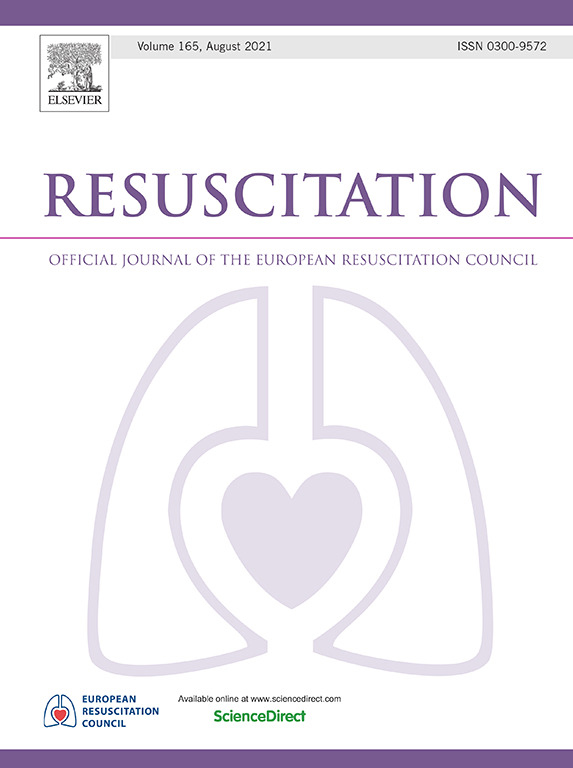院外复苏期间实时脑血氧测定与预后。
IF 4.6
1区 医学
Q1 CRITICAL CARE MEDICINE
引用次数: 0
摘要
背景:缺氧脑损伤是院外心脏骤停(OHCA)后常见的死亡模式。我们评估了复苏过程中区域脑氧饱和度(rSO2)的变化过程,以了解其与自发循环恢复(ROSC)和功能生存的关系。方法:我们对郊区社区急诊医疗服务(EMS)治疗的OHCA患者进行前瞻性观察调查。实时rSO2根据ROSC和脑功能分类(CPC) 1-2定义的有利生存进行总体表征。我们还计算了ΔrSO2,定义为实现ROSC的患者从ROSC前到ROSC后的rSO2变化,并与接受CPR但未实现ROSC的患者的rSO2时间匹配差异进行了比较。结果:在140例符合条件的病例中,有93例入选。其中,55% (n=51)达到ROSC, 10% (n=9)在CPC 1-2下存活。应用脑血氧仪后,rSO2中位数为33%(四分位数范围=22,45%)。初始rSO2不能预测随后的ROSC (38% ROSC vs 27%无ROSC, AUC=0.61, p=0.13)或随后的有利生存(45% CPC 1-2 vs 32% CPC 1-2无生存,AUC=0.77, p=0.17)。然而,与时间匹配的持续无脉搏相比,ROSC患者的实时rSO2和ΔrSO2更高(rSO2=60% vs. 33%, AUC=0.84, p2=11% vs. 1%, AUC=0.85, p2和ΔrSO2在ROSC周围生存期更高(rSO2=63% vs. 46%, AUC=0.74, p=0.06;ΔrSO2=29% vs. 10%, AUC=0.77, p=0.04)结论:较高的rSO2和ΔrSO2值可识别瞬时ROSC,并预测获得ROSC的患者良好的神经系统生存。本文章由计算机程序翻译,如有差异,请以英文原文为准。
Real-time cerebral oximetry and outcomes during out-of-hospital resuscitation
Background
Anoxic brain injury is a common mode of death following out-of-hospital cardiac arrest (OHCA). We assessed the course of regional cerebral oxygen saturation (rSO2) during resuscitation to understand its association with return of spontaneous circulation (ROSC) and functional survival.
Methods
We conducted a prospective observational investigation of OHCA patients treated by Emergency Medical Services (EMS) in a suburban community. Real-time rSO2 was characterized overall and according to ROSC and favorable survival defined by Cerebral Performance Category (CPC) 1–2. We also calculated ΔrSO2, defined as the change in rSO2 from pre- to post-ROSC among those who achieved ROSC, and compared to a time-matched rSO2 difference among those receiving CPR who did not achieve ROSC.
Results
Of 140 eligible cases, 93 were enrolled. Of these, 55 % (n = 51) achieved ROSC and 10 % (n = 9) survived with CPC 1–2. Upon cerebral oximeter application, the median rSO2 was 33 % (interquartile range = 22.45 %). Initial rSO2 did not predict subsequent ROSC (38 % ROSC vs 27 % no ROSC, AUC = 0.61, p = 0.13) or subsequent favorable survival (45 % CPC 1–2 vs 32 % no survival with CPC 1–2, AUC = 0.77, p = 0.17). However, real-time rSO2 and ΔrSO2 were greater upon ROSC versus time-matched ongoing pulselessness (rSO2 = 60 % vs. 33 %, AUC = 0.84, p < 0.001; ΔrSO2 = 11 % vs. 1 %, AUC = 0.85, p < 0.001). Among those who achieved ROSC, rSO2 and ΔrSO2 during the peri-ROSC period was greater among those with subsequent favorable survival (rSO2 = 63 % vs. 46 %, AUC = 0.74, p = 0.06; ΔrSO2 = 29 % vs. 10 %, AUC = 0.77, p = 0.04)
Conclusion
Greater values of rSO2 and ΔrSO2 identified instantaneous ROSC and predicted favorable neurological survival among those who achieved ROSC.
求助全文
通过发布文献求助,成功后即可免费获取论文全文。
去求助
来源期刊

Resuscitation
医学-急救医学
CiteScore
12.00
自引率
18.50%
发文量
556
审稿时长
21 days
期刊介绍:
Resuscitation is a monthly international and interdisciplinary medical journal. The papers published deal with the aetiology, pathophysiology and prevention of cardiac arrest, resuscitation training, clinical resuscitation, and experimental resuscitation research, although papers relating to animal studies will be published only if they are of exceptional interest and related directly to clinical cardiopulmonary resuscitation. Papers relating to trauma are published occasionally but the majority of these concern traumatic cardiac arrest.
 求助内容:
求助内容: 应助结果提醒方式:
应助结果提醒方式:


